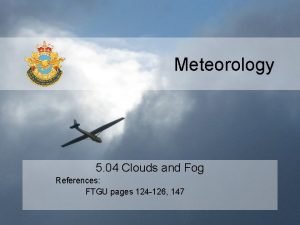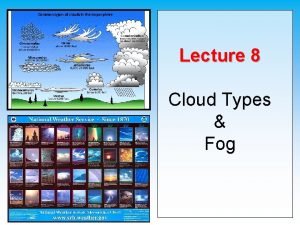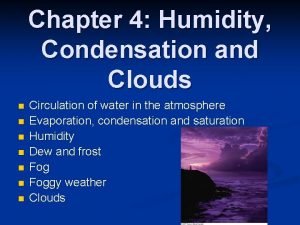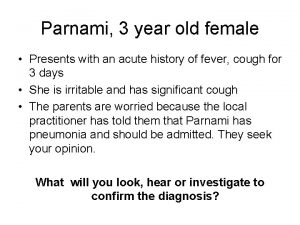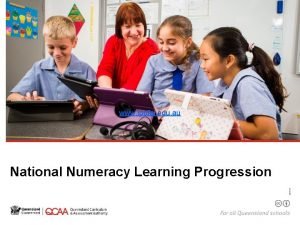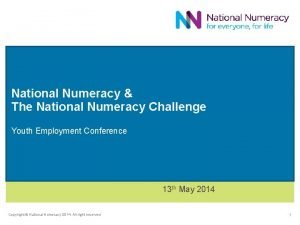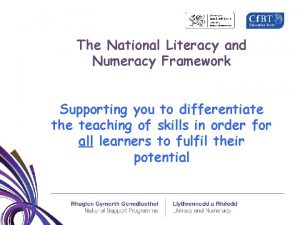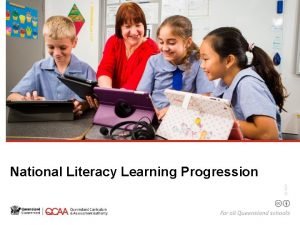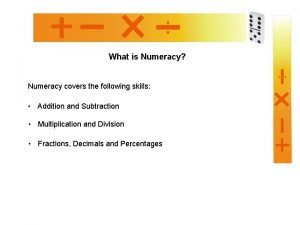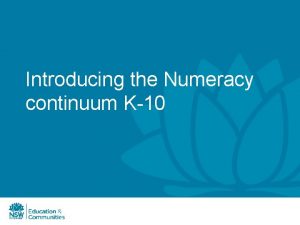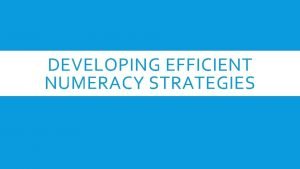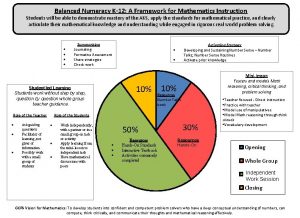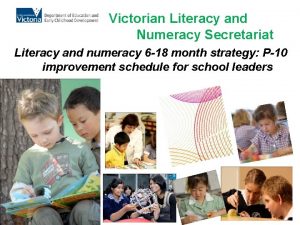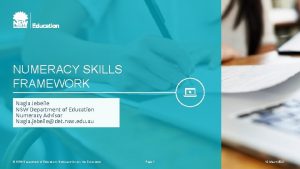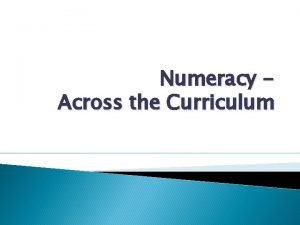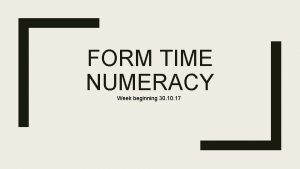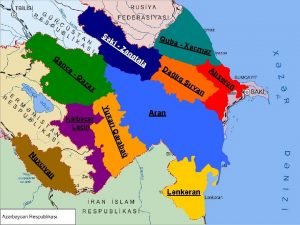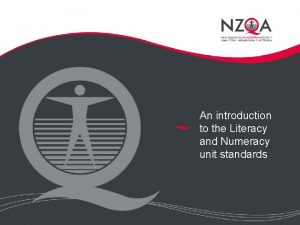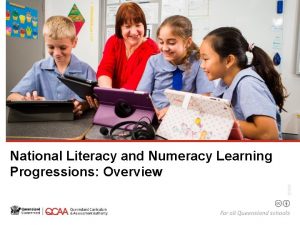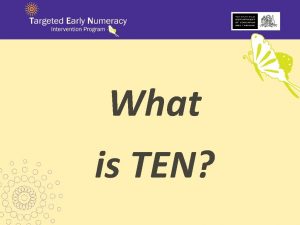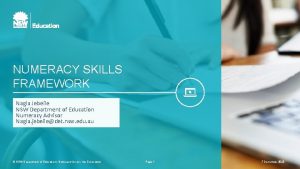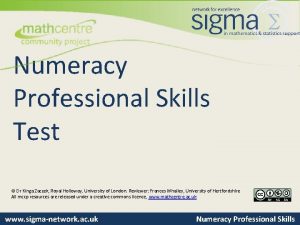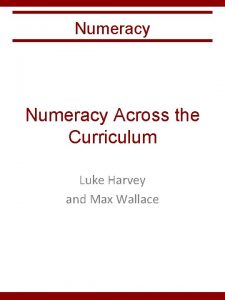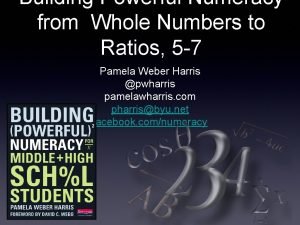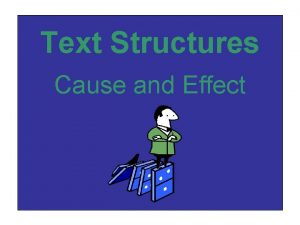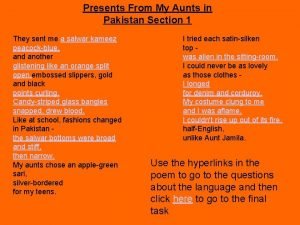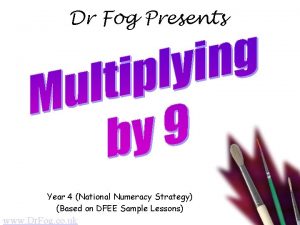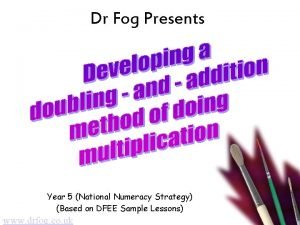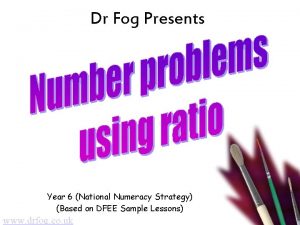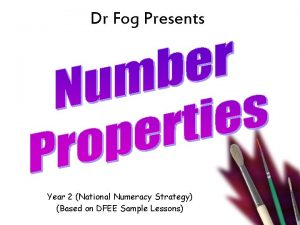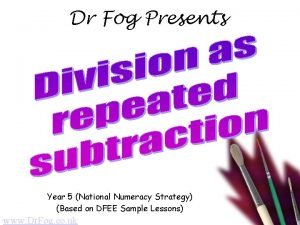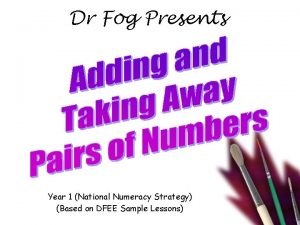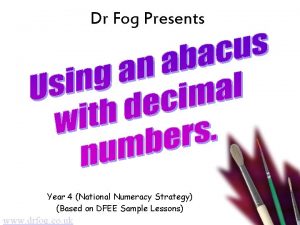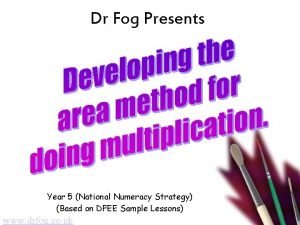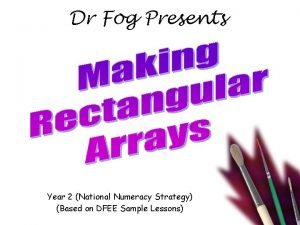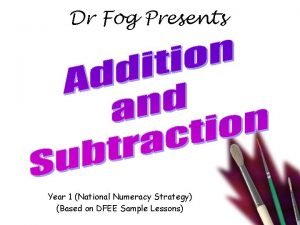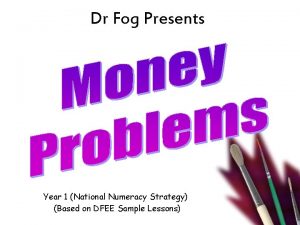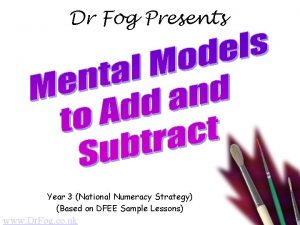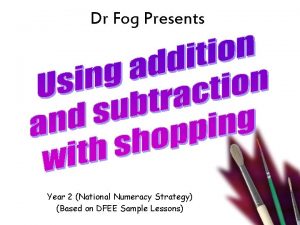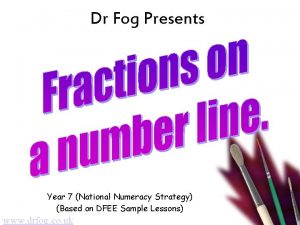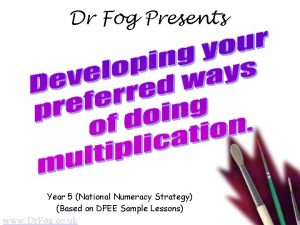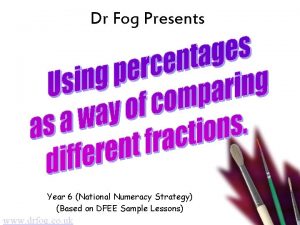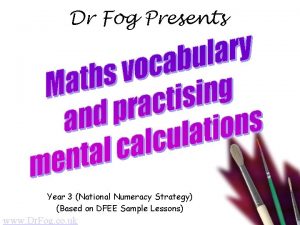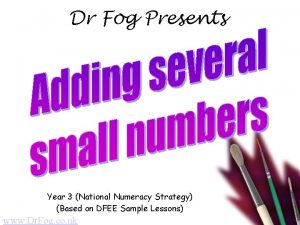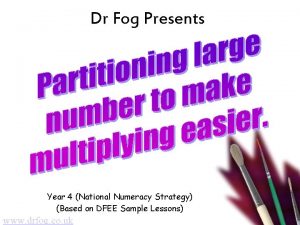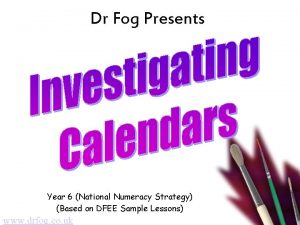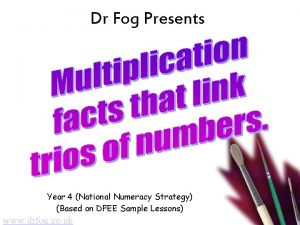Dr Fog Presents Year 4 National Numeracy Strategy






























- Slides: 30

Dr Fog Presents Year 4 (National Numeracy Strategy) (Based on DFEE Sample Lessons) www. Dr. Fog. co. uk

Resources • • • 1 – 6 dice (for each group) 2 – 9 number cards (for each group) Cubes and number lines (optional) 1 -9 dice (optional) Counters.

Mental Learning Objective • I can use all four number operations.

Mental Learning Task • I am going to write 4 digits in board. • The four operation signs • And a two-digit target number.

Mental Learning Task 357 9 - x + Target 50 • Get a number as close as possible to the target number. • You can only use each digit once.

Mental Learning Task 357 9 - x + Target 50 • How close did you get? • Write the closest two answers on the board.

Mental Learning Objective • I can use all four number operations.

Main Learning Objective • I can find remainders. • I can round answers up and down. • I can practise division of two-digit numbers with remainders.

Key idea

Main Learning Task • Today we are going to work with divisions but this time the answers won’t always be whole numbers.

Main Learning Task 20 10 = 23 10 = • In the last lesson you were working with division calculations like the first one.

Main Learning Task 20 10 = 23 10 = • Try the calculations like the second one.

Main Learning Task 20 10 = 23 10 = • Imagine you have 23 apples to share between 10 children. • How many apples would each child get? • How many apples are left over?

Main Learning Task 20 10 = 23 10 = • The ‘bit left over’ is called a remainder and the answer should be written with this word in it 23 10 = 2 remainder 3

Main Learning Task • Try to solve each of these questions. • Write a number sentence for each one. 41 4 = 25 3 = 39 5 = 362 100 =

Main Learning Task • Looking again at the sum… • 41 4 • What would you need to subtract from 41 in order to do an exact division? • You need to take off 1 • This is called what? • A remainder

Main Learning Task • Now we are going to look at rounding up and rounding down answers to make sensible solutions

Main Learning Task • If a class of children need to fit on the tables at the Science Centre. • Each table holds 6 children. • If there are 34 children, how many tables will be needed? • Will five tables be enough? • No as the left over children need a table to! This is an example of rounding up

Main Learning Task • Suppose you want to buy pencils at the school fair. • The pencils cost 9 p and you have 50 p to spend. • How many pencils can you buy? • You can buy 5 pencils. • How much money have you left over? • Why can’t you buy 6 pencils? • This is an example of Rounding Down

Main Learning Task • Today we are going to play ‘Leftovers’. • Each group needs 1 -6 dice. • Each group needs a pile of number cards 2 – 9.

Main Learning Task • One child is in charge of the dice. • Another is the card dealer. • The card-dealer gives a card to each group member. • This is your division number for that round.

Main Learning Task • The dice handler rolls the dice twice and reads out the dice number in order to make a twodigit number. • Each child must write down a division calculation made up of this number, divided by their division number. • And answer with its remainder.

Main Learning Task • Read your calculation to the rest of the group. • The child with the largest remainder wins a counter. • Shuffle the cards and play again. • The first child to collect three counters is the winner.

Main Learning Task • Simplification: • Children use cubes and number lines for support. • Challenge: • Children use 1 -9 dice to generate numbers up to 100 or above.

Main Learning Objective • I can find remainders. • I can round answers up and down. • I can practise division of two-digit numbers with remainders.

Plenary • Were any of your divisions easier than others? • What was easy about them? • Which were the more difficult ones?

Plenary • How did you work out the difficult ones? • Did you know what the remainder would be before working out the sum.

Plenary • Write down a list of ten two-digit numbers. • Divide these tens numbers by your age. • What remainders do you get?

Review of Key Idea • I can practise dividing two-digit numbers with remainders. • Did you learn this in today’s lesson?

Where Can I Find More Resources Like This? • You can now visit my teaching resource website at http: //www. Dr. Fog. co. uk • You can click here to search for more of my teaching resources. • Click here to visit my TES shop!
 Fog types aviation
Fog types aviation Advection fog vs radiation fog
Advection fog vs radiation fog Advection fog vs radiation fog
Advection fog vs radiation fog A 26 year old female presents
A 26 year old female presents Chapter 17 neurologic emergencies
Chapter 17 neurologic emergencies Acara numeracy continuum
Acara numeracy continuum National numeracy challenge
National numeracy challenge Literacy and numeracy framework
Literacy and numeracy framework Australian curriculum literacy progressions
Australian curriculum literacy progressions Poem for primary school leavers
Poem for primary school leavers What numeracy covers
What numeracy covers Numeracy continuum
Numeracy continuum Developing efficient numeracy strategies
Developing efficient numeracy strategies Numeracy framework
Numeracy framework Literacy and numeracy secretariat
Literacy and numeracy secretariat Numeracy skills framework
Numeracy skills framework Numeracy across the curriculum audit
Numeracy across the curriculum audit Grade 10 numeracy assessment practice test
Grade 10 numeracy assessment practice test Form time numeracy
Form time numeracy Scottish survey of literacy and numeracy
Scottish survey of literacy and numeracy Qax numeracy
Qax numeracy Numeracy unit standards
Numeracy unit standards Literacy and numeracy progressions
Literacy and numeracy progressions Seal numeracy
Seal numeracy Targeted early numeracy intervention program
Targeted early numeracy intervention program Pizza small slices
Pizza small slices Professional skills test numeracy
Professional skills test numeracy Dr luke harvey
Dr luke harvey Building powerful numeracy
Building powerful numeracy Presents cause-effect relationship *
Presents cause-effect relationship * Presents from my aunts in pakistan
Presents from my aunts in pakistan
